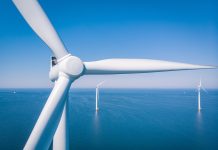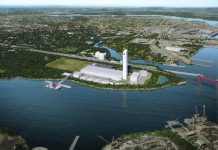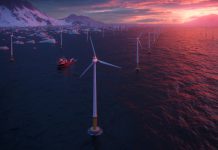In operation since 1996, the Advanced Structures and Composites Center at the University of Maine in Orono, is an 83,000 square foot lab employing 40 scientists and engineers and 100 graduate and undergraduate students. The center performs research and development in North America and around the world for the advanced study of materials and construction. “We are unique for our ability to design new materials, manufacture and test under one roof,” says Dr. Habib Dagher, P.E., Director. “We can design a tower, make a tower and test a tower; design a plate, test a plate and make a plate.”
The ISO 17025 accredited facility has 10 laboratories under one roof, housing labs for composite materials, manufacturing science, resin infusion, polymer/interface science, environmental-durability testing, mechanical testing, nondestructive evaluation (NDE), advanced microscopy, and large-scale multidegree-of-freedom static and dynamic structural testing. The center also houses two pilot plants: a Composites Extrusion Plot Plant and a Strand Composites Pilot Plant.
A new 37,000 square foot Offshore Wind Laboratory was recently constructed and enables the design, manufacture and testing of structural hybrid composite and nanocomposite components for deep-water offshore wind structures such as blades, towers, and spars.
Fixed or Floating Turbines
The Dynamic Marine Simulation Basin is one of only two facilities in the world with high quality wind and waves for scale model testing of fixed or floating offshore wind turbines with a tank measuring 32 feet by 100 feet by 12 feet. “We test blades measuring up to 230 feet and we are a certified lab accepted by agencies across the country and throughout the world,” Dr. Dagher says. “We look at materials from nano-scale to full-scale. That is very unique.” Dagher says the facility is also home to the largest structural testing facility that accommodates 230-foot long structures for testing with anchor forms. The facility is designed for use to apply loads in static and fatigue loading and blade testing at a million pounds of load.
The lab can also manufacture in vacuum infusion and perform filament winding or extrusion processes and compression molding of materials. In about a year a robot will be installed to automate the manufacturing process. “The robot in design now, travels on a track system and can produce complex 7-axis composite shapes up to 200 feet in length.
The robot will be used to construct bridge towers for wind turbines and blades by using interchangeable heads, performing all aspects of manufacturing from producing fibers and resin, curing, inspection and completion.
The ability to test blades measuring 230 feet is the largest facility available in the United States in an academic institution. “We are also unique in our environmental testing in that we have a large environmental chamber with activators that take a joint between a blade and the foundation of the structure and test under environmental factors such as relative humidity and temperatures from -50 degrees below zero to 150+ degrees to generate fatigue loading by bending and twisting the way the wind would do to a structure,” he said. “We are able to conduct these tests under salt water to simulate offshore bending and twisting. I don’t know of any facility that can do that under salt-water conditions. This allows us to determine failures of materials in nano and failure of design to improve systems.”
From Coupon to Full-Scale
Dagher says the center also works in atomic force microscopy and scanning electron microscopy to understand materials at a small scale. Testing from coupon level at six inches long, to a full-scale 230-foot-long structural level under static and fatigue loading and analyzing modeling and material structures are part of the expertise of this lab. “During our 16 years of existence, we have a long history of experience and a large staff tailored to the needs of our clients,” he said. “One of the benefits of using our lab is that our partner companies don’t have to build their own facilities. If they built a facility from scratch it would cost them $100 million. This is our specialty and we partner with companies to perform the work.”
The center offers a preferred customer program where a client books time with the facility for two, three or four years, giving them priority in the labs. Many clients also appreciate the connections they build with graduate and undergraduate students and the university can become a feeder program where a company provides scholarships and in return hire the student at the end of their graduate studies in their own operations. “The student interaction with our clients and the scholarships and tuition assistance they receive is good experience for our students. In return, the companies connect with many high-caliber people for their operations.”
In the past five years, the center has provided industrial collaboration on more than 300 product development and testing projects with small, start-up companies and large corporations.
To learn more:
Email hd@umit.maine.edu or call 207-581-2138 or visit www.aewc.umaine.edu.



























